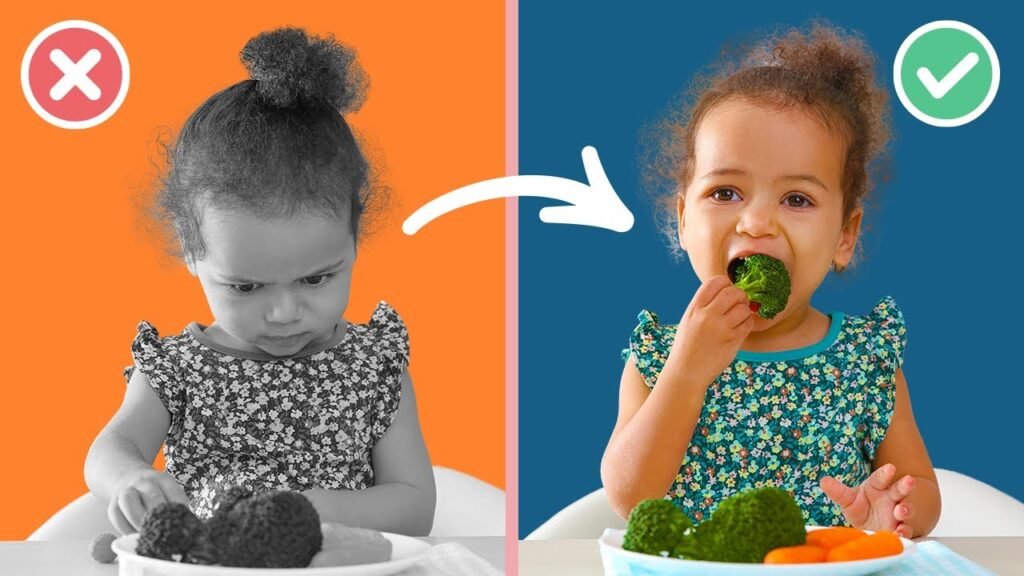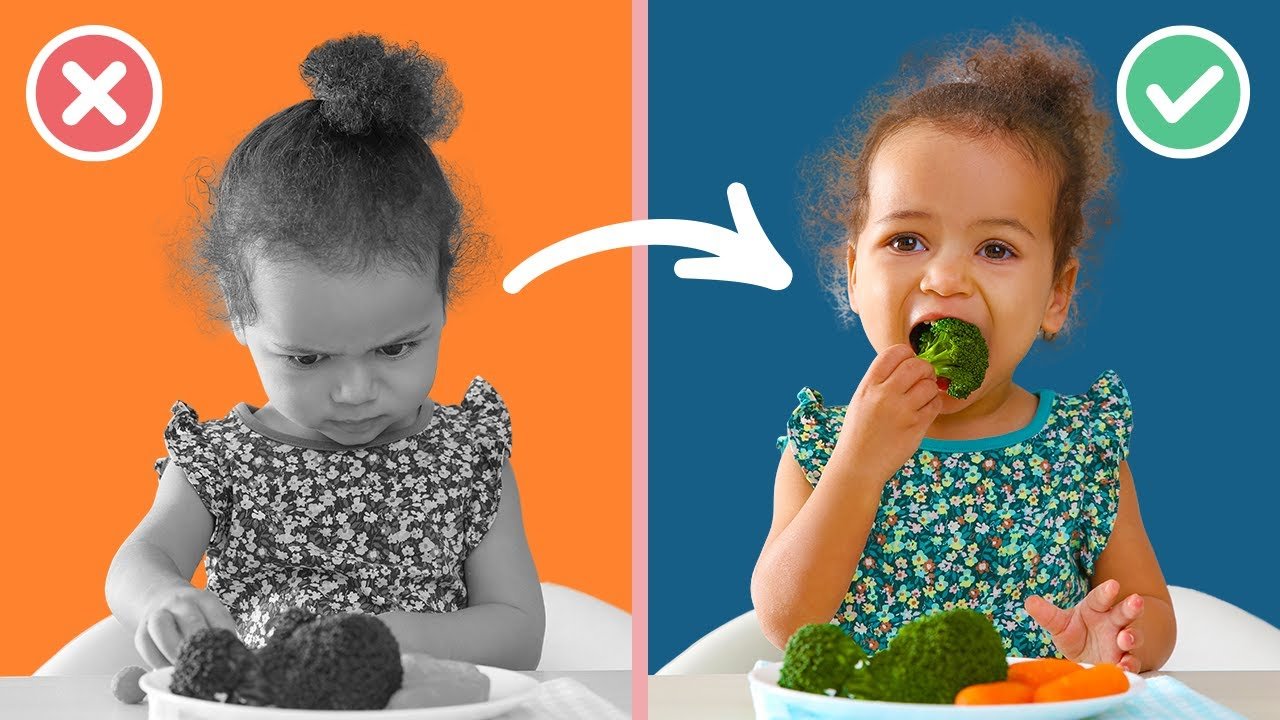Toddlers are notorious for being picky eaters, but there are effective ways to expand their food preferences. One strategy is to serve preferred foods alongside new or non-preferred foods, encouraging them to explore and try new flavors. It’s also helpful to limit constant snacking and space meals about two and a half hours apart, ensuring that toddlers are hungry and more willing to try new foods. Social modeling, such as eating the same food as the toddler, can positively influence their willingness to try new foods. Pairing new foods with familiar sauces or dips can also mask flavors and textures, making it easier for toddlers to give new foods a chance. Lastly, presenting food in a fun and creative way can overcome resistance based on appearance. Repeated exposure to new foods without pressure can help toddlers become more comfortable and willing to try them. Avoiding common mistakes such as pressuring or forcing toddlers to eat can make picky eating more challenging. In Emma Hubbard’s video, “How to Get Toddlers to Eat ANYTHING,” she shares simple yet effective tips to expand toddlers’ food preferences and make meal times easier for both toddlers and parents. Whether you already have a picky eater or want to prevent picky eating habits, these strategies can help introduce a wider variety of foods to your toddler’s diet. With patience and persistence, you can help your toddler become more comfortable with new foods and create a positive eating environment.
Ways to Expand Toddlers’ Food Preferences
Toddlers are often picky eaters, but there are ways to expand their food preferences. By implementing these strategies, you can help your toddler become more adventurous and willing to try new foods. Here are some effective methods to encourage your toddler to broaden their palate.
Serving preferred foods alongside new foods
It’s no secret that toddlers have strong preferences when it comes to food. They often gravitate towards familiar foods and resist trying new ones. One effective way to expand their food preferences is to serve their preferred foods alongside new or non-preferred foods. This approach allows your toddler to feel more comfortable while also introducing new flavors and textures. By incorporating small amounts of new foods alongside their preferred options, you can gradually increase their exposure to different flavors without overwhelming them.
Limiting snacking and spacing meals
Toddlers have a tendency to snack throughout the day, which can decrease their appetite during mealtimes. To increase their willingness to try new foods, it’s important to limit constant snacking and space meals approximately two and a half hours apart. By allowing your toddler to feel hunger before each meal, they will be more receptive to trying new foods. Be sure to offer water between meals rather than juices or milk, as these can be filling and reduce their hunger.
Social modeling
Toddlers are highly influenced by their surroundings, particularly when it comes to eating habits. By eating with your toddler and consuming the same food, you can positively influence their willingness to try new foods. A study conducted by Adessy and her team in 2005 found that children were more likely to eat new foods when adults were eating the same type of food or food of the same color. Therefore, sitting down and eating the same food as your toddler can encourage them to branch out and try new foods.

Pairing new foods with familiar sauces or dips
One of the reasons toddlers resist trying new foods is their fear of unfamiliar tastes and textures. To overcome this, you can pair new foods with familiar sauces or dips that your toddler already enjoys. This strategy helps mask or eliminate the flavor and texture of the new food, making it easier for your toddler to try. Allowing your toddler to smother the new food with their favorite sauce or dip can help them gradually become more open to trying new foods. Experiment with different sauces and dips such as ketchup, hummus, salsa, yogurt-based dressing, peanut butter, mayonnaise, pesto sauce, sour cream, cream cheese, and barbecue sauce.
Presenting food in a fun and creative way
Sometimes, toddlers reject food based solely on its appearance. To overcome this obstacle, present food in a fun and creative way to make it more appealing to your toddler. This doesn’t mean you have to become a master chef; simple changes can make a big difference. You can use cookie cutters to make fresh fruit and vegetables into fun shapes or animals. Another idea is to use skewers or toothpicks to make food more visually enticing. You can also arrange food to create a face or shape, or even change up the cutlery used. By making mealtimes more enjoyable and visually appealing, your toddler may become more willing to try new foods.
Repeated exposure without pressuring
Patience is key when trying to expand your toddler’s food preferences. It’s important to repeatedly expose them to new foods without pressuring them to eat. Continuously offering the food without forcing them to eat it will help them become more comfortable with it over time. Encourage your toddler to interact with the new food, smell it, touch it, and eventually, take small bites. The goal is to create a positive association with the new food and gradually increase their comfort level.
Avoiding common mistakes
While implementing the strategies mentioned above, it’s crucial to avoid common mistakes that can hinder progress. Pressuring or forcing your toddler to eat can create a negative association with food, making picky eating more challenging to overcome. It’s essential to create a positive and relaxed environment during mealtimes, offering new foods alongside preferred options without any pressure to eat them. Avoid using food as a reward or punishment, as this can lead to an unhealthy relationship with food. Understanding and avoiding these common mistakes will contribute to a more successful approach in expanding your toddler’s food preferences.
Next video for avoiding common mistakes
For further tips on avoiding common mistakes when dealing with picky eaters, make sure to watch the next video provided by Emma Hubbard. This video will provide valuable insight and guidance to ensure you are on the right track to expanding your toddler’s food preferences. Remember, patience and consistency are key when it comes to helping your toddler become more open to trying new foods.
Conclusion
Expanding toddlers’ food preferences can be challenging, but it is possible with the right strategies. Serving preferred foods alongside new ones, limiting snacking, social modeling, pairing new foods with familiar sauces or dips, presenting food in a fun and creative way, repeated exposure without pressuring, and avoiding common mistakes are effective methods to encourage your toddler to try new foods. By implementing these strategies consistently and with patience, you can help your toddler develop a diverse and healthy eating pattern.

